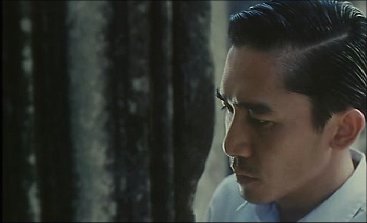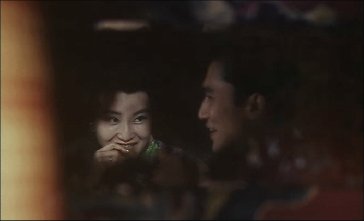|
Text and layout © Ed Shum, 2003. Ed Shum asserts the moral right to be identified as the author of this work |
|
Long Reviews |
|
Much has been said above regarding the structure of the film and the role of the viewer, but this would all mean nothing if the film didn’t ‘work’ anyway, if we didn’t care about the characters, empathise with them, feel the texture of their very existence and consciousness. On the subject of texture, the production is absolutely stunning. By the end of the film you can feel the very living space which is depicted, yet it is shot in such a way that the layout is never made absolutely clear. The sets are rich and dazzling to the eye, much care has been lavished over the details. Consider the opaque green cups and saucers used at the restaurant; identical to those at the cafe in DoBW. Even the mirrors in the film have been grimed up. Before watching this film I was already aware that Maggie’s role would be a cheongsam-fest, so I failed to pay real attention to this aspect. It is only on later viewings that I have appreciated, not just the aesthetics of the gloriously over-elegant costuming, but the fact that she changes clothes every scene (and apparently within scenes: often the editing manages to hide time transitions well - like the second restaurant sequence which occurs over two occasions, and the following shot in the taxi from another occasion!). The result is a subjective highlighting of her character, as if created from memory. Tony is highlighted too, his restrained clothing directing attention to his slicked hair and his carefully internalised expression. |
|
Review of In The Mood For Love (2000) |
|
|
|
...Continued... [Page 3] |
|
End |
|
Both performances are excellent, good news considering so much of the film hinges upon how the characters are depicted. Maggie gives an expressive, visibly pained performance, where she uses her entire self to express her emotions. Tony gives a subtle, controlled depiction, where even during his more introspective moments he keeps the bulk of his expression internal. For this reason his character invites analysis: into his pains, regrets and motivations. The film alludes to his role in driving the development of the situation; we see hints of him and his wife arguing (whereas we never see Maggie with her husband in anything less than amity), he tries to speak to Maggie first at the noodle stall, he waits some nights for her to pass, he plays on her interest in literature, he apparently is the driving force behind the roleplays they partake in. And when they are together he emphasises the licence which they have in light of their spouses’ affair (Tony’s soup-slurping depiction of Maggie’s husband being memorable), and he calls Maggie at work. Eventually, when it comes to separation he makes Maggie go through the painful process of a farewell roleplay. |
|
On the other hand, perhaps such is the effect of Tony’s (Cannes Award-winning) depiction that one can’t help but read in to him. For her part, Maggie is far from simply compliant to Tony - she demands attention yet keeps hold of the mantra that they won’t be like the others - and it is her character who returns to haunt Tony’s memory at the end of the story, where we are shown the universal pain and regret felt by both, consigning any question on the creation of the affair into irrelevance. As Tony says, it doesn’t matter who started it - it has already occurred. What WKW seems to be creating is a premise which presents itself as the inevitable consequence of coincidence, narrative structuralism demanding the affair to occur - the caging of his characters within the bounds of some fate-tempting eventuality. Yet we learn of this to be merely the presentation: the centre of the story - as with all of WKW’s tales - is around a male character whose consciousness we are made privy to. This is emphasised by the ‘memory’ epigram. So we are invited to gauge just how his memory has ‘subjectified’ the narrative into inevitable consequence - when, by his memories, the only thing we can be sure of is a love had and lost. |
|
The choice of music in the film is, as ever, inspired. The selection is quite minimalist, and there is no pure incidental music, meaning each tune has a full presence in its setting. Complementing the Umebayashi Shigeru theme are a collection of catchy Nat King Cole numbers which initially form a ‘restaurant’ theme where the leads meet alone. But WKW allows the themes to transpose from a fixed location to ‘float’ later in the film. This means that a ‘real’ prop-like object such as a restaurant tune has made the move into the ephemeral, into the realm of the memory as a node to recognition and emotion. The effect of this on the audience is comparable to the effect of the jukebox tune (‘Forget Him’) on Leon Lai in Fallen Angels - although there the song taints whatever Leon associates it with. Here, the songs are associated with the connection between the leads, and provide a rhythm to their actions and thoughts. Perhaps the only gripe is that the songs are so fitting that they lack the quirky, unexpected feel which songs have in some of WKW’s other works. |
|
In many ways, the cinematography - always so central in WKW films - also works to the musical rhythm. Often, the shooting style is restrained and balanced as the routine of living is emphasised: the same shots from the same angles of staircases, alleyways, windows. The use of balance finds the camera particularly giving space to walls and the set. So many shots feature half a screen of wall, whether directly before the camera or oblique into the distance - some of these have a ‘peekaboo’-style feel (complemented by the many prop-‘blocked’ shots), but the emphasis on the walls as witness/co-constituents in the story is especially important given the coda, with its balanced shot of Tony in ‘communion’ with a wall. What is remarkable is that this scene was only added on at a late stage, apparently without planning - and yet it ties in with the initial shot in the film (always important with WKW) of the camera tracking along Rebecca Pan’s apartment wall, taking in the ‘history’ as recorded in framed pictures and snapshots. It can only be hypothesised whether WKW already had the general theme of the coda in mind when shooting the rest of the film. |
|
Hear the wind sing: Tony Leung’s faintly mysterious coda gives us a final chance to read into his character, but again with a level of inherent uncertainty. Whereas, in the past WKW would have used voiceover (or another instantly noticeable technique) precisely for such a moment, to give an often pithy and ironic insight into the character, in this film he leaves the moment for us to construe. |
|
Then, occasionally, the cinematography breaks into movement and energy to emphasise a rhythm or a mood. For example, when Maggie enters Tony’s neighbouring apartment for the first time, the camera shoots from every conceivable angle, reflecting excitement and curiosity in contrast to routine. And when the Umebayashi Shigeru theme plays, the camera floats in gloriously slow tracking shots and pans, the slow motion giving the scene a suspended, memory-like unreality. As mentioned before, many shots are oblique: shot through props blocking the camera, and often the characters are seen in mirrors, the grime and distortion adding to the obliqueness but also creating artificial juxtapositions. There seems to be a purpose here, as the only time we truly see the leads let down their guards and, apparently, happy is when we see them get down to their joint venture of crafting a martial arts serial. This occurs in room 2046: ironic given that we expect that location to be where they get together for physical love rather than to write fiction. There the camera pans slowly as they smile and talk - dialogue inaudible - with their images reflected to us in grimy mirrors. The moment has an unreal feel - we take it secondhand, reflected and distorted and subjectified like seeing an experience through the lens of one’s memory. This is further expanded upon by shots of twirling smoke and gently rippling curtains, Tony telling Maggie, ‘This is not real’ when she feels the pain of reality. Both are caught on the cusp of this unreality, and perhaps it is only here where they can find happiness, in a realm where possibility is neither realised nor frustrated. |
|
Page: |
|
Page: |


|
The flower of youth: we rarely see the leads let down their guards and appear happy. Throughout the film they worry about appearing proper, or occasionally kid themselves as to just what is developing. It is when they write fiction that we see some kind of freedom, as if they are in a different world where anything can happen - without consequences in reality. |